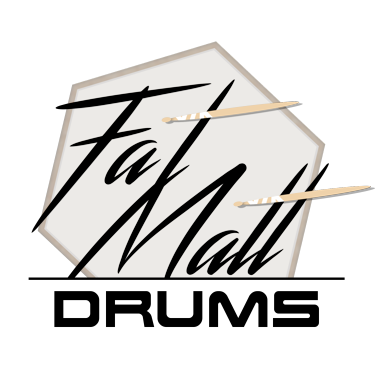Ghost Meat has the bones of an accent tap exercise, but the muscle of a doublestroke exercise and the skin of a singlestrokes exercise. The name was inspired by the notion of “ghost notes” which are the subtle inner beats that add character and direction to an overarching rhythmic figure… it’s always crucial that ghost notes be sweet and low. This warm-up employs solid, monotone slurred ruffs (“pudidahs”) in both ninelet and sextuplet contexts before adding some accents to create true “ghost note” contexts. The bottom half of the piece shifts from the accent-tap focus to a singlestroke rolls focus, and it will require considerable maturity to accurately shift between the ninelet, sixteenth-note, and sextuplet rhythms of the singlestrokes.
21st Century Sanford Man
21st Century Sanford Man (2021) is a truly fundamental way to work on double beats and to connect double beat fundamentals to the doublestroke roll. Segments of the exercise must be performed with a “maximum rebound” (or “pause at the up”) approach, whereby the performers focus on allowing every stroke to return to the attack height and simply stay there before the next attack. This extreme approach to emphasizing rebound allows performers to work through their issues in maximizing both rebound and velocity (sound production) in both double beat and doublestroke roll contexts.
Buck Dub Paradiddle
Double Hang Time
Double Hang Time (2021) focuses on the concept of “hang time” as it pertains to connecting the “Sanford” approach to the doublestroke roll. Second-note rebound is especially important in doublestroke rolls, so it is great to have an exercise that challenges this aspect of doublestroke fundamentals. Unfortunately, the aggressive feel of the Sanford-type pattern often translates poorly into doublestroke roll fundamentals because of the difference in “hang time” (the time between the second note of a doublestroke and the very next note on the same hand, during which the stick is rebounded but not being thrown into the drum). This exercise juxtaposes the Sanford pattern with an inverted roll breakdown so that the aggressive, high-velocity, high-rebound approach facilitated by the Sanford pattern can be applied with the increased hang time of a doublestroke roll pattern.
A common tendency is to lighten up on the doublestroke roll in order to more easily fill the hang time with motion; less velocity into the drumhead means a slower rebound, which means your hand is not awkwardly paused at the attack height during the hang time. The challenge is to play with high velocity, allow a lot of rebound, and be comfortable waiting for the next attack. In this manner, the benefits of a Sanford-type exercise can be best applied to doublestroke roll patterns.
Chow Down
Chow Down (2021) is an all-around and all-in-one ensemble warm-up targeting the high school level. It consists of five “movements”: 1. Legatos, 2. Bucks, 3. Doubles I, 4. Doubles II, and 5. Triplet Rolls. Each movement could be used as a standalone warm-up, and you can gradually work each movement into the full sequence as the season progresses, so that you have both a warm-up book, and a cohesive ensemble warm-up, however you are able to deploy it. It may be beneficial for the snares to learn the tenor part in some places, as some passages involve the snares playing a fundamental exercise pattern while the tenors play an even more fundamental breakdown of the motion involved in that pattern.
This warm-up was originally conceived for tri-toms instead of quad or quint tenors, so that is the arrangement you will hear in the Virtual DrumLine (VDL) recording. I am providing the score to both arrangements here:
Dub/Huk
I inflicted Dub/Huk (2010) on the Athens Drive HS Drumline in order to help work on doublestrokes: specifically, second note quality in doublestroke rolls, and sixteenth-note consistency (timing and quality) for paradiddle figures.
The first half of the piece builds the doublestroke roll and inverted roll from their one-handed breakdowns. I like working on inverted rolls because the second note of the doublestroke is placed on the eighth note partials, rather than sixteenth-note upbeat partials; i.e. deficiencies in timing and quality of those notes will be more obvious to the ear and mind, allowing these deficiencies to be corrected.
The second half works on a syncopated hucka-dig (one-handed breakdown of a paradiddle-diddle) pattern and then fills it in to the corresponding paradiddle figure. Ensemble timing is tricky for this part; accents on the fourth sixteenth note partial will tend to be late, while those on the upbeat eighth notes will tend to be early. This warm-up is a huge bag of mess without dedicated practice with a metronome.
The bass drum part is such that all the written notes could be played as a single unison part.
Double Tap
I wrote Double Tap (2010) on one fine evening when I got stuck on NC State's campus during a snowstorm. They had a showing of Zombieland for students, so after fleshing out this warm-up in the dorms with a couple buddies, it was pretty obvious what I should call it.
It's styled after the very "stock"-sounding double beat warm-ups that generally centre on some sanford-esque pattern, but I wanted to incorporate different hand speeds, as well as an emphasis on the eighth-note pulse within a triplet roll.
While this piece was never used and would prove difficult for a line of typical skill, it is nonetheless worth taking a look at.
Matt A-B
Matt A-B (2010) is a variation on the A/B/C Sanford-type double beat exercise, arranged for full battery. I used this with the 2009-2010 Athens Drive HS Indoor Drumline to cover the demands of a stick control exercise, a paradiddle exercise, and a double-beat exercise, all in one piece that was constructed piecemeal from other parts of their audition packet (e.g., 8-on-a-hand bass splits). It turned out really well for its simplicity.
Swingerbeat
Swingerbeat (2008) highlights three different contexts for doublestrokes: the second note rebounding to re-attack at the same height as the first stroke, the second note being downstroked to re-attack at the tap height, and the second note being upstroked to re-attack at the accent height.
While there really isn't any emphasis on paradiddle figures, the hucka-dig motion is employed heavily.
The last bar of the piece is very much like the tap-off. In a line setting, it would probably work to just repeat the warm-up as if the last bar is the tap off (i.e. add the pickup from the last 24th-note of bar 1 to the final bar, and resume at bar 2).
Bread & Butter: Dubs
Bread and Butter: Dubs (2007) is a stock-type double beat exercise that would be well-suited to a high school drumline that is ready to do their homework. Take it slow (slower than the 112 BPM marked… try 80 BPM!) to work on the rhythms, and hey, it turns out that working on doubles that slowly is also very beneficial! It comes from the Bread and Butter packet from the original FatMattDrums website, and I think it has aged well enough to deserve new life here.
Edit 14 November 2021: The link to the pdf was broken, and I have fixed it.











